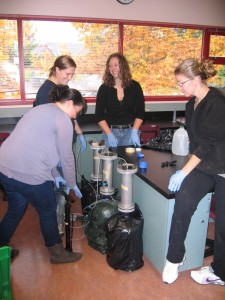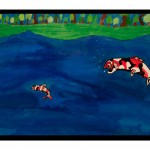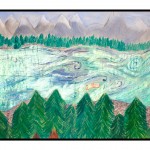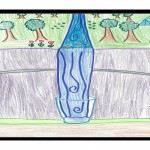Interview with Bernhard Peucker-Ehrenbrink, Woods Hole Oceanographic Institution
by Ari Daniel Shapiro
Download a pdf of this interview
[audio:http://coseenow.net/files/2012/06/bernhard_01.mp3]
THE SCIENCE OF THIS PROJECT:
This is a long-term project on observing rivers – how the biogeochemistry of these rivers is affected by what we as a society do to them. Ultimately, the goal is to understand how these river systems respond to anthropogenic perturbations.
THE BROADER IMPACTS COMPONENT OF THIS PROJECT:
We need people to work with us locally. The sampling of these rivers can only be done right if we have people onsite who can respond rapidly to events like storms and floods. So we go into the schools to get students interested in their local rivers. We work with local partners to teach young people about what rivers mean to them. How their lives and surroundings are impacted by river systems. We also ask the students to paint and draw portraits of their local rivers.
AUDIENCE:
Which audience have you targeted with the BI activities in this project?
Our primary audience is students of all ages – from grade 2 to 12. And they live all over the globe, from British Columbia to the Russian Arctic to the Congo.
What are the benefits of working with this audience?
First of all, it’s a tremendous amount of fun for us to see the creativity of the students. But we also need them. They’re not an appendix to our science program. We depend on local communities because they know their local system much better than we do.
And hopefully at some point, we could host a video conference with people in British Columbia and the Russian Arctic or China or India. That’s really our long-term goal – bringing these communities into contact with one another.
And the challenges?
The challenges are varied. Sometimes we have numerous administrative hurdles – ethics reviews and paperwork to make sure that what we’re doing in the schools is legitimate and safe. And I understand why some school districts prefer to do business that way – it’s to protect the students.
In other schools, there can be logistical challenges of transforming our idea into action. In the Congo, for instance, the schools don’t have art supplies. So we have to bring everything – the paper, the pencils, and the paint.
How do you deconstruct your science to reach non-expert audiences?
That’s always a challenge. But for water and for rivers, it’s relatively straightforward because everybody knows a river. We either live on them, or use them for swimming, fishing, or transportation.
As for the specifics of what we’re measuring in the rivers, that can be harder to translate. And yet, we can talk about E. coli concentrations in the water, mercury in fish, and heavy metal contamination. Those types of measurements are relevant to everybody.
What have you learned about your audience from doing your BI project?
I’ve learned how closely someone’s view of their river is tied to where and how they live. We have artwork from heavily populated, industrialized areas. And the students depict lots of bridges, boats, traffic on the river, issues of pollution, saving the earth, and saving the river. When I contrast that with the artwork from students in more pristine environments, I see beautiful landscapes, animals, and people hunting and fishing.
PARTNERSHIPS:

Who were the members of your support team?
Overall, we’re probably working with close to 50 people. There’s a core science group interested in all aspects of river science. We also have partners at institutions that focus on undergraduate education. We even work with professional photographers and videographers who accompany us into the basins to document what we do there. And we’ve just started working with museums to design art exhibits. So it’s a pretty comprehensive and varied group.
How did you go about designing this project and setting up your partnerships?
The earlier version of this project focused on monitoring large Arctic rivers. And then we decided to expand the project globally and look at other interesting river basins. For example, the Congo, the Ganges, the Brahmaputra – big basins that captured our scientific interest but also where we could forge collaborations. Then there are some pet basins in there, like the Fraser River, which is undammed on its main stem. That’s almost unheard of today – a free-flowing, wild river.
How do you balance your research with your BI activities?
That balance is natural for us because the outreach is an integral part of the science. We also have local partners in the basins who are interested not only in the science, but working with the schools. So we just have to provide a little bit of guidance and financial backing, and our partners help make the integration smooth and seamless.
EVALUATION:
Did you use a project evaluator or gather evidence on your own?
In retrospect, I would have done things differently because we didn’t include any formal evaluation of this program. That’s partly because the project has evolved over the years. There was no need for formal evaluation when we wrote the proposal because we simply wanted to embed this project into our research activities and slowly expand it.
The way we know that it’s working is by our track record. Schools ask to participate and they keep coming back year after year. The students are excited about it. There is interest in our art cards as well, where we select artwork done by the students and print them out on greeting cards to distribute.
BUDGET:
In your budget planning process, how much did you allocate for your BI activities and why?
We included $60,000 for the outreach component, which accounts for about 2.5% of the total budget. That’s what we need to make it work. We pay local people to help us in the schools, and we pay for art supplies, framing, exhibit preparation, and the writing of explanatory text. We need to work with professionals who have different types of expertise than we do.
FINAL THOUGHTS:
Has participation in BI projects influenced your ability to more effectively communicate?
Yes, and it’s partly because the artwork is such an easy entrance into the science. You show someone how students view these river systems, and then there’s this “Ahhh, ohhh, look at this, that’s beautiful,” and you get into a conversation. It’s a way of educating people about their river systems, and it’s a very smooth entry into the science. The science and the outreach are connected.
What are some overall lessons that you’ve learned from your BI activities?
It’s fun to involve local communities in research whenever you can do it. These communities also benefit from being part of the research on local systems that matter to them. It’s a real partnership.
Do you have a story related to your BI activities that really touched you?
We held the first art competition in the Fraser Basin, and I didn’t know how it would go – how many schools would participate, and how the selection of the winning student would work out. Among the top-ranked pieces of student artwork, there were some really beautiful drawings. Including one of a boat with indigenous First Nations symbols on it. There was a totem pole on the side of the river. It was very intricately done. So I asked the local partners about the artist. They told me it was designed by a student who was living in a small apartment with lots of siblings and a single mother working multiple jobs. And yet, this student was drawn to participate in our art competition. He won a wooden box of colored pencils and art supplies, and I was delighted that it would let him continue to make art. That certainly made a difference to me – seeing students of all backgrounds participating in this outreach activity, and enjoying it. I found that incredibly meaningful.
ABOUT ME:
What is your research interest?
I’m trying to understand the history of seawater, how its chemistry has changed over hundreds of millions of years, and what it can tell us about the evolution of our planet. The core motivation for this project is to understand how carbon atoms move between the land and sea.



